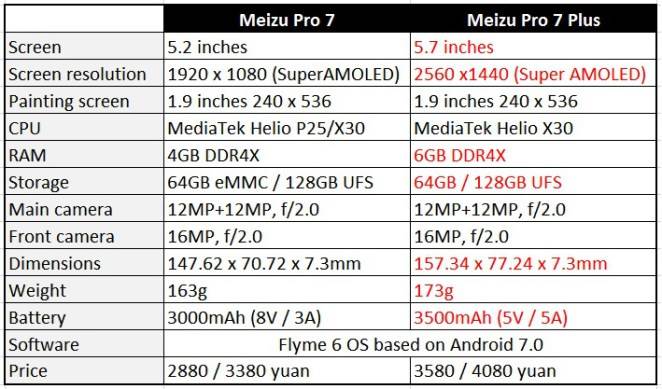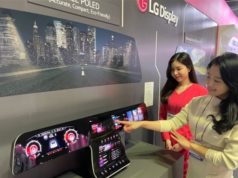The mobile market changes too fast. Recently we have been using flip phones. Then they started to come in a unibody design. The manufacturers canceled any buttons on them. The displays became the main operational part. That’s why the screens became larger and larger. The batteries got larger as well to provide longer life for those large-screen devices. And now probably we are at the very beginning of a new era of smartphones. Meizu has launched the Pro 7 and Pro 7 Plus. They are great devices with all the trendy features such as dual-camera, bezel-less screen, powerful chip, large memory, etc. But what’s more interesting to us the Meizu Pro 7 and Pro 7 Plus sport a secondary screen on the back. You may say, we have already seen something like that on the Russian YotaPhone. But agree, there is no handset with such a feature available in the market right now.
As for this display, it’s conditionally called ‘painting screen’. The latter has been designed with one purpose in mind – to provide the most required information when the phone lying face down. Honestly, this problem has been a major concern for Meizu for a long time. The manufacturer even tried to solve it via LED lights. I guess you remember those lights on the Meizu E2. But they can only notify about some cases. Lights can’t show who’s texted you and who’s calling you. Now when the Meizu Pro 7 and Pro 7 Plus are out, the company employees can calm down. Moreover, if this is the best solution for the case, it will become a mainstream.
However, those two phones are from the same line, and it’s reasonable why they have many common features and design elements. But they also differ from each other. So we decided to find out what features don’t match on this two models, and how they behave in the real life.
One of the most charming things about this device is the packaging. It comes in an unusual shape. In comparison to the Meizu Pro 6S’s package, it looks modern and promising.
The Meizu Pro 7 and Pro 7 Plus are considered to be the most colored phone of the company. The basic variant comes in black, gold, and red, while the advanced model comes in black, gold, and silver.
This handset really looks like a real flagship with astonishing design lineaments. However, this device looks stylish only from the back. The front of the phone is identical to the rest models of this family. So, we are a bit disappointed.
Anyway, the back comes with a painting screen that has a low power consumption.
As for the higher version, it comes with a larger screen. Therefore, it’s bigger.
The Meizu Pro 7 is considered to be the basic mode, while its sibling comes with advanced features. So it’s reasonable why the Pro 7 sports a 5.2-inch screen at Full HD resolution, and the Meizu Pro 7 Plus is packed with a 5.7-inch screen at 2K resolution. However, the display matrix is the same for both devices, Super AMOLED.
Like the Meizu Pro 7 Plus sports the same screen matrix as the Pro 6 Plus. Let’s look at three primary colors comparison results. Actually, there is no big difference between them.
Now let’s take a peek at the color scale test.
The Meizu Pro 7 Plus provides warmer colors at the colorful photo test.
The brightness effect is almost the same for both handsets.
Both handsets come with a secondary screen located on the upper left side of the rear panel. But we have talked too much about this screen. That’s why I am offering not deep in details now.
Read the Meizu Pro 7 Plus review to find more about its painting screen.
The camera sensors are the same on both models. This means the Meizu Pro 7 as well as the Pro 7 Plus features a dual-camera with 12MP sensors carrying a model number of IMX386. Thanks to them the phones can take excellent shots. The pixel area is 1.25 microns. So the phone is capable of taking better photos in dark conditions.
This camera is also capable of taking better white-black photos. Thanks to a multi-frame noise reduction algorithm the screen purity is improved. Moreover, there is a special ‘ultimate black and white mode’, which provides photos with more details and level.
Since the configuration of the Meizu PRO 7 and PRO 7 Plus cameras, we use the Meizu PRO 7 to test, the following we look through the real proof of the appearance of Meizu PRO 7 imaging performance, first in the default mode.
As for the default auto mode, we can see the shutter time is very short and ISO value is very low. The latter guarantees too high photo clarity.
As we are dealing with a dual-camera handset, it’s reasonable to check its ability of blurring. The photos below prove it in the best way.
The Meizu Pro 6 was packed with a Helio X25 chip. It’s a premium SoC with ten cores, but many handsets are packed with it. So the Pro 6 couldn’t benefit from this chip. That’s why the name of this smartphone is often accompanied with the phrase of ‘False flagship’. To fix this shortcoming Meizu packed the Pro 7 / Plus with the Helio X30, but there is also a Helio P25-powered variant for those who don’t care about the performance much.
As for this processor, the X30 uses a 10nm process technology. Thus we expect from it to provide the way better performance than all other chips in the globe.
Read: Qualcomm Snapdragon 835 vs Mediatek Helio X30
Like the previously used X25 it uses a tri-cluster architecture and comes with two A73 cores clocked at 2.6GHz, four A53 cores clocked at 2.2GHz and four A35 cores running at 1.9GHz. According to the official data, the X30’s performance has been improved by 35% in comparison to the X20. Moreover, the power consumption was decreased by 50%. As for the GPU, it uses PowerVR 7XTP-MT4 clocked at 850MHz. thus it is faster than the X25 by 2.4 times.
Other features of the MediaTek Helio X30:
- This cheap is packed with a 16+16MP dual-lend video processor (VPU) as well as image signal processor (ISP) supporting real-time DOF, wide-angle zoom, quick auto-exposure, low-light real-time noise reduction and much more.
- It supports high dynamic range (HDR) imaging technology on a hardware level.
- It supports ImagiqTM dual-lens 2x optical zoom.
- It supports MediaTek’s MiraVisionTM EnergySmart screen power-saving technology. Thanks to this technology the X30 saves 10% of overall power and 25% of screen power.
- When the ambient light source changes, the camera control system automatically adjusts.
- It supports up to 8GB LPDDR4X 1866MHz memory. The LPDDR4X allows the system to save 50% energy in comparison to the LPDDR3. Plus, the overall performance is increased by 50%.
Well, let’s see how this chip behaves in benchmarks.
AnTuTu result of the Meizu Pro 7
The Meizu Pro 7 scores 145.501 points at AnTuTu. It’s the way better than the Helio X30’s score of 100.000. On the other hand, this chips still unable to compete with Snapdragon 835 that scores over 180.000.
We know the number of cores affects the heating of a chip. That’s why many chip makers try not to increase the cores number. Qualcomm acts in this way. It tries to get the maximum from a single core rather than add more cores to improve the performance. But MediaTek wants to go by another way. So let’s see how it has solved the problem of overheating.
After 15 minutes of stress testing, we can see the Meizu PRO 7 CPU performance floats between 50% -100%, the overall load between 40% -100%.
As for a single core test, the CPU load can reach 100%. So any of cores can perform full frequency operations.
To learn the game performance, we use 3D Mark in the Sling Shot Extreme items to test. The final score is 2155 (it’s 2837 for the SND835). Thus there is a 25% performance gap between these chips.
We know eMMC storages are the way slower than UFS storages. So as there are two models of the Meizu Pro 7 packed with each of those storage types, we used AndroBench to explore more.
Read Chuwi LapBook 12.3 vs Jumper EzBook 3 Pro vs T-bao Tbook Air: The Best Cheap Laptop to learn more about the storage types.
The benchmark showcases the read speed reaches up to 496.69MB / s, while the write speed is 217.58MB / s for the eMMC 64GB variant. The UFS 2.1 storage version shows 700MB / s.
Only a few smartphone makers can boast of their own system. Meizu is one of them. The Meizu Pro 7 and Pro 7 Plus use the new Flyme 6, but the kernel version has risen to Android 7.0. The company claims it has made tons of researches and brought its intelligent thinking engine, One Mind to a new level. Thanks to self-learning abilities it is able to provide efficient solutions for different cases.
As for the interface, this version looks more dynamic.
However, it continues Flyme 5’s immersive design that is coupled with sixth version’s new colors. So we can state the colors are the tramp of Flyme OS. Plus, there are 200 new animation effects.
The task manager has changed a lot. Now you can learn which app how much memory occupies. This is the best way for giving a priority to an app when closing them.
Thanks to a new intelligent storage function, the system understands which messages are not important for the user based on his/her habits, and doesn’t show them.
The pseudo-base station security function has been added as well.
Plus, it comes with a list of protection improvements for Alipay or WeChat payment processes.
There is also a new password keyboard allowing users to avoid third-party apps to read the pass.
At last, there is a parallel space. The Flyme 6 offers three modes – privacy, guest and children’s modes. The Privacy and guest modes can be accessed not only via passwords but via fingerprints as well.
The Meizu Pro 7 and Meizu Pro 7 Plus use different fast charge technologies. The former one supports mCharge 3.0 8V / 3A program that is used by myriad Meizu handsets currently. It can provide up to 24W fast charge power.
The Meizu PRO 7 Plus uses a new low-voltage fast charge mCharge4.0 technology providing 5V / 5A program. The maximum output is 25W power.
The Pro 7 Plus is equipped with a 3500mAh battery,…





![[CES 2026] Quest For Perfect Color…Samsung To Push](https://loginby.com/itnews/wp-content/uploads/2025/12/CES-2026-Quest-For-Perfect-Color…Samsung-To-Push-100x75.jpg)

